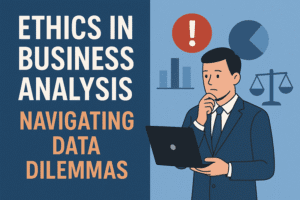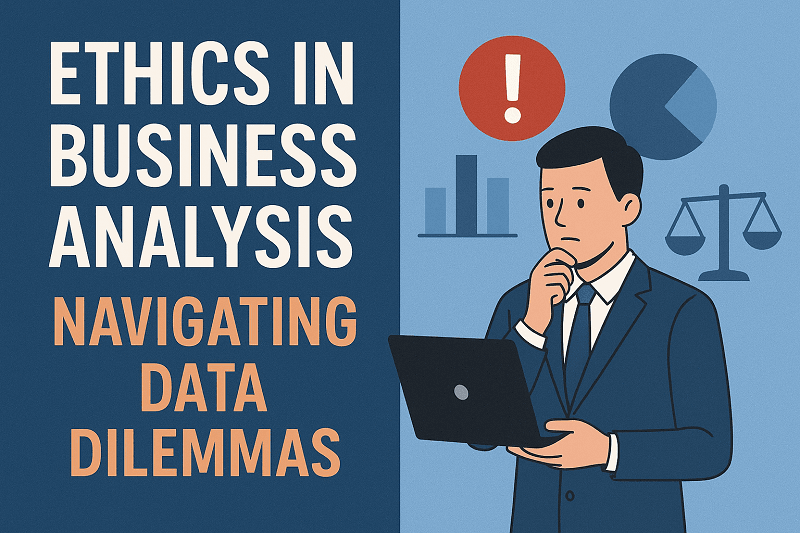The Silent Power of Data

The Unexpected Ethical Minefield Behind “Just Data”
In today‘s organizations, data is like fuel — it helps create insights, improve processes, customize experiences, and make predictions.
Yet for a Business Analyst, this “fuel” can also bring hidden dangers.
Many people think:
“Data is just numbers — what could go wrong?”
But in reality, even data that seems harmless can:
– Affect whether someone gets hired
– Decide who gets a loan
– Influence how customers see a company
– Shape public opinion
– Lead to legal problems
Why Data Isn’t Neutral
Data comes from people, is interpreted by people, and is used on people.
This means:
– Biases can get into the data
– Privacy issues can appear
– Wrong interpretations can cause real harm
As a Business Analyst, you work at the crossroads of technology, company needs, rules, and how data affects people.
Ethical thinking is really important here.
Unmasking the Data Dilemmas
Here are some real situations where Business Analysts face tough choices.
Case Study 1: When Algorithmic Bias Causes Inequality
Example: A Hiring System Rejecting Female Applicants
A company uses an AI tool to choose job candidates.
The Business Analyst notices that women are being selected much less often
Root Cause
The AI was trained on old hiring data where most hires were men, which built in a gender bias.
The BA’s Ethical Role
A responsible Business Analyst should:
– Check where the data comes from
– Ensure fairness
– Point out risks of bias
– Suggest changes to the model
– Make sure fairness is measured properly
Real-Time Example:
As the BA, you look at the model and say:
“I see the model is using old data that might not match today’s goals.
We need to check for bias and set rules for fairness.”
This helps prevent legal issues and hurt the company’s reputation.
Case Study 2: Navigating the Privacy Line
Example: A Retail App Tracking User Location Without Clear Consent A mobile app collects user location to send personalized offers. But users only agreed to share basic information.
When complaints start, the BA dashboard shows a rise in people uninstalling the app.
The Ethical Dilemma
The data is available, but users didn’t clearly agree.
The company wants personalization at all costs.
The BA’s Role
You suggest:
– Rewriting the consent message
– Changing data tracking to be opt-in
– Keeping data anonymous
– Adding a privacy review before new features
Real-Time Example:
You tell product owners:
“We can offer personalized promotions, but only if people agree to it.
Otherwise, we risk legal problems.”
Benefits:
– Protects customer trust
– Avoids future legal issues
– Builds better relationships with customers
Case Study 3: Good Intentions, Unintended Problems
Example: Intelligent Insurance Pricing Based on Driving Behavior
A BA leads a project to offer personalized car insurance based on driving habits.
Goal: Reward drivers who are careful.
Outcome: Data shows that people in lower–income areas pay more due to heavy traffic — creating an unfair situation.
The BA’s Responsibility
You must:
– Check for unintended effects
– Suggest limits on the model
– Ask: “Are we punishing people for things they can’t control?”
Real-Time Example:
You recommend using driving behavior alone and removing location–based scoring.
This stops unfair treatment and supports more fair pricing.
Your Ethical Toolkit: Principles and Practices
To handle data dilemmas, Business Analysts need a strong sense of ethics.
1.Setting a Clear Ethical Guide
Key principles for all Business Analysts:
– Transparency: Explain how data is collected, used, and processed.
– Fairness: Make sure models and decisions don’t show bias.
– Accountability: Keep records and accept responsibility for outcomes.
– Privacy: Collect only what is needed and protect user data.
2.Practical Strategies for Ethical Business Analysis
– Data Anonymization Methods:
Masking, tokenization, aggregation, randomization, differential privacy
– Informed Consent Tips:
Clear privacy messages, opt-in options, no hidden terms, easy way to change your mind
– Bias Detection Tools:
A/B testing for fairness, checking data balance, reviewing sensitive data, using model explainability tool.
3.Building an Ethical Framework in Your Company
As a BA, you can help by:
– Creating ethical checklists
– Conducting data risk reviews
– Setting up privacy check processes
– Training team members on ethics
– Keeping good documentation
This builds a culture of responsible data use.
Beyond Compliance: The Benefits of Ethical Business Analysis
Ethics isn’t just about avoiding problems — it can give your company an edge.
1.Trust = Strong Reputation
Companies that handle data ethically attract:
– Loyal customers
– Quality partners
– Better employees
2.Risk Avoidance
Ethical practices help avoid:
– Lawsuits
– Legal penalties
– Public backlash
– Project failures
3.Competitive Advantage
Consumers now choose brands that value:
– Privacy
– Transparency
– Social responsibility
A BA who ensures these values becomes a valuable employee.
Future–Proofing Your BA Career
Proactive Ethical Thinking
New challenges will come from:
– Artificial Intelligence
– Internet of Things (IoT)
– Personalized experiences
– Biometric data
– Predictive analytics
Staying Updated
A Business Analyst should follow:
– GDPR rules
– Ethical AI standards
– Global data protection laws
Become an Ethical Leader
You can drive change by:
– Running ethics workshops
– Creating ethical guidelines
– Influencing decision–making leaders
– Standing up for user rights
Ethical Business Analysts are the future leaders of responsible innovation.
Conclusion:
Ethics isn’t a separate task — it’s part of every decision a Business Analyst makes.
From collecting data to interpreting findings, the BA plays a key role in ensuring fairness, honesty, and real–world impact.
Ethical Business Analysts don’t just build better systems — they help build a better world.
Related Articles:
Business Analyst Roles & Responsibilities
https://www.bacareers.in/business-analyst-roles-and-responsibilities/Data Analysis for Business Analysts
https://www.bacareers.in/data-analysis-for-business-analysts/Risk Management in Business Analysis
https://www.bacareers.in/risk-management-in-business-analysis/Agile Methodology for Business Analysts
https://www.bacareers.in/agile-methodology-for-business-analysts/BRD vs FRD
https://www.bacareers.in/brd-vs-frd/
External Links
- GDPR Guidelines: https://gdpr.eu/
- OECD AI Ethics Principles: https://oecd.ai/en/ai-principles
- ISO Standards for Data Privacy: https://www.iso.org/standards.html

Business Analyst , Functional Consultant, Provide Training on Business Analysis and SDLC Methodologies.

